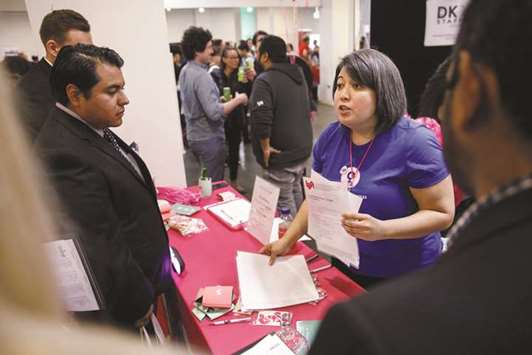The number of Americans filing for unemployment benefits rose just marginally last week, suggesting strong job growth in March that should underpin consumer spending.
Other data yesterday offered an upbeat assessment of the economy, echoing a similar tone struck by the Federal Reserve on Wednesday when it raised interest rates and forecast at least two more hikes for 2018.
A gauge of future economic activity increased for a fifth straight month in February and a measure of factory output climbed this month to a three-year high.
Prices of single-family homes surged in January.
“The economy appears to be well entrenched in a virtuous cycle, with seemingly little risk of being derailed in the near term,” said Jim Baird, chief investment officer at Plante Moran Financial Advisors in Kalamazoo, Michigan.
“That bodes well for employment and household spending in the coming months.”
Initial claims for state unemployment benefits increased 3,000 to a seasonally adjusted 229,000 for the week ended March 17, the Labour Department said yesterday.
Claims dropped to 210,000 during the week ended February 24, which was the lowest level since December 1969.
Economists polled by Reuters had forecast claims dipping to 225,000 in the latest week.
Claims have now been below the 300,000 threshold, which is associated with a strong labour market, for 159 straight weeks.
That is the longest such stretch since 1970, when the labour market was much smaller.
The labour market is considered to be near or at full employment.
The jobless rate is at a 17-year low of 4.1%, not too far from the Fed’s forecast of 3.8% by the end of this year.
The US central bank said on Wednesday it expected that “labour market conditions will remain strong.”
US financial markets were little moved by the data as plans by President Donald Trump to impose tariffs on Chinese imports intensified concerns about a global trade war. Stocks on Wall Street were trading lower, while prices for US Treasuries rose.
The dollar was little changed against a basket of currencies.
The four-week moving average of initial claims, viewed as a better measure of labour market trends as it irons out week-to-week volatility, rose 2,250 to 223,750 last week.
The claims data covered the survey period for March non-farm payrolls.
The four-week average of claims fell 1,750 between the February and March survey periods, suggesting another month of solid job gains.
The economy created 313,000 jobs in February.
“The message of the unemployment claims data remains that companies are holding on to the labour they have and the labour market is tight,” said John Ryding, chief economist at RDQ Economics in New York.
Economists are optimistic that tightening labour market conditions will start boosting wage growth in the second half of this year.
That should help to support consumer spending, which slowed at the start of the year.
Consumer spending could also get a lift from rising home prices, which are helping to boost household wealth.
In a separate report yesterday, the Federal Housing Finance Agency (FHFA) said its house price index jumped a seasonally adjusted 0.8% in January after increasing 0.4% in December.
Home prices surged 7.3% in the 12 months through January.
House price inflation is being fuelled by a chronic shortage of properties available for sale.
The FHFA’s index is calculated by using purchase prices of houses financed with mortgages sold to or guaranteed by mortgage finance companies Fannie Mae or Freddie Mac.
“While this may overstate the underlying trend given that it is stronger than several other related measures, most measures of house prices show solid rates of appreciation continuing recently despite weakening in a variety of home sales measures over the past several months,” said Daniel Silver, an economist at JPMorgan in New York.
Though sluggish consumer spending could hold back economic growth in the first quarter the outlook is bright.
In another report, the Conference Board said its Leading Economic Index increased 0.6% in February after advancing 0.8% in January.
The economy’s improved prospects were also underscored by a fourth report from data firm Markit showing its manufacturing sector flash PMI increased to a reading of 55.7 in March, the highest level since March 2015, from 55.3 in February.
The survey showed an increase in factory employment this month.

A company representative speaks with job seekers during a career fair in Los Angeles. Initial claims for state unemployment benefits increased 3,000 to a seasonally adjusted 229,000 for the week ended March 17, the Labour Department said yesterday.


